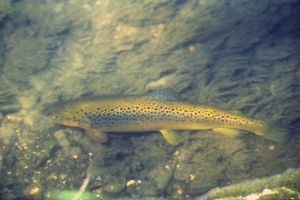Key points
- Investigating the winter ecology of brown trout in English chalk streams.
- Trout density was positively related to river depth, possibly to shelter from predators, but not related to temperature.
- Fish exhibited daily patterns of behaviour.
- Growth was positive even during winter.
Background
 Most research into the winter ecology of stream-dwelling salmonids (the family of fish comprised of salmon, trout, chars, freshwater whitefishes, and graylings) has been performed in northern regions, for example Canada and Scandinavia. Here, waterways tend to be physically diverse, with large fluctuations in water flow and temperature, poor in nutrients and affected by ice.
Most research into the winter ecology of stream-dwelling salmonids (the family of fish comprised of salmon, trout, chars, freshwater whitefishes, and graylings) has been performed in northern regions, for example Canada and Scandinavia. Here, waterways tend to be physically diverse, with large fluctuations in water flow and temperature, poor in nutrients and affected by ice.
This study investigated how brown trout behave and grow in winter in southern English streams, which are comparatively warmer, more stable environments with very different physical and chemical characteristics.
What they did
This study examined in detail the environment in a southern England chalk stream, recording the composition of the river bed, depth, speed of flow and bank vegetation along a 270m stretch. River and ambient temperatures were recorded along this stretch throughout two winters. The size, weight, distribution, movement and activity of brown trout was also surveyed along the study area throughout these two winters. These results were used to calculate the distribution, behaviour and growth of trout with relation to the river characteristics during this time.
What they found
More fish were found in areas of deep water, but there was no relationship with water flow speed or temperature. Similar to observations made elsewhere, trout displayed regular daily activity patterns of behaviour. The majority of fish tended to stay in one area, with limited movement to other territories. Trout growth was positive during winter, and approached optimal levels of growth predicted based on the assumption that fish are sufficiently fed.
What does this mean?
Understanding the behaviour and performance of salmonids in different habitats is important for developing appropriate strategies to preserve or rehabilitate these habitats in the face of urbanisation, abstraction, changes in land use and climate change. This study demonstrates that trout growth is positive in winter in English chalk streams, and sheds light on their behaviour in this system, some of which align with but some differ from those observed in contrasting environments worldwide.
Read the original abstract
Kemp, P.S., et al (2017). Challenging convention: the winter ecology of brown trout (Salmo trutta) in a productive and stable environment. Freshwater Biology, 62: 146-160.
 Does this page interest you?
Does this page interest you?
If the answer is yes, sign up for our FREE weekly newsletter and get all the latest GWCT research news, event invites and offers delivered straight to your inbox.
Sign up FREE to the Weekly GWCT Newsletter >